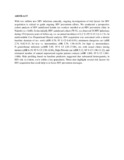Risk Factors for HIV Acquisition in a prospective Nairobi based female sex worker cohort.

View/
Date
2015Author
McKinnon, LR
Izulla, P
Nagelkerke, N
Munyao, J
Wanjiru, T
Shaw, SY
Gichuki, R
Kariuki, C
Muriuki, F
Musyoki, H
Gakii, G
Gelmon, L
Kaul, R
Kimani, J
Language
enMetadata
Show full item recordAbstract
With two million new HIV infections annually, ongoing investigations of risk factors for HIV acquisition is critical to guide ongoing HIV prevention efforts. We conducted a prospective cohort analysis of HIV uninfected female sex workers enrolled at an HIV prevention clinic in Nairobi (n = 1640). In the initially HIV uninfected cohort (70 %), we observed 34 HIV infections during 1514 person-years of follow-up, i.e. an annual incidence of 2.2 % (95 % CI 1.6-3.1 %). In multivariable Cox Proportional Hazard analysis, HIV acquisition was associated with a shorter baseline duration of sex work (aHR 0.76, 95 % CI 0.63-0.91), minimum charge/sex act (aHR 2.74, 0.82-9.15, for low vs. intermediate; aHR 5.70, 1.96-16.59, for high vs. intermediate), N. gonorrhoeae infection (aAHR 5.89, 95 % CI 2.03-17.08), sex with casual clients during menses (aHR 6.19, 95 % CI 2.58-14.84), Depo Provera use (aHR 5.12, 95 % CI 1.98-13.22), and estimated number of annual unprotected regular partner contacts (aHR 1.004, 95 % CI 1.001-1.006). Risk profiling based on baseline predictors suggested that substantial heterogeneity in HIV risk is evident, even within a key population. These data highlight several risk factors for HIV acquisition that could help to re-focus HIV prevention messages.
